Stream to 3D - Video File Conversion
Converting 2D Videos to 3D [NA for Real-Time Product]
This mode is accessed via the "Convert" menu button. Stream to 3D can convert most formats of 2D video file into 3D. The 3D video file output supports industry standards and is not specific to VR. In particular, note that Stream to 3D is an ordinary windows desktop application and has no dependencies on VR software sub-systems.
The files can be used with any device supporting 3D playback, e.g. by being loaded onto a VR headset (or accessed by a Windows share) and played back with VR media players (such as BigScreen, Sky Box VR Player, Pigasus etc.), 3D TVs or 3D projectors (e.g. via Kodi, VLC Media Player, Nova Player etc).
The video below provides a comprehensive demonstration and tutorial on Stream to 3D's video file conversion capabilities from 2D to 3D:
Important: For GPU accelerated video encoding, FFMpeg has a dependency on your GPU graphics driver, so you need to make sure that your GPU graphics driver is up to date. You will receive an error from Stream to 3D, telling you to upgrade your graphics driver, during video conversion if there is a mismatch.
In addition to the video, the guidance below will also help you to get the most out of your Stream to 3D experience.
To convert a 2D video file into a 3D version, click Convert in the main menu and select the file. If you have the Configuration Wizard enabled, then you will be prompted for your preferences on how you would like conversion to be handled, see here for detail on the Configuration Wizard prompts that will be presented. You can enable and disable the Configuration Wizard or put it in "auto" mode from Settings. When disabled, or in "auto" mode, the Wizard preference questions are not displayed.
Below is a simple scenario of converting a single 2D video to 3D, without the use of the Configuration Wizard. A more complex example involving batch conversion is described later.
You can control a range of aspects of the conversion process in the "Settings/Conversion" menu. See Screen Shot below:
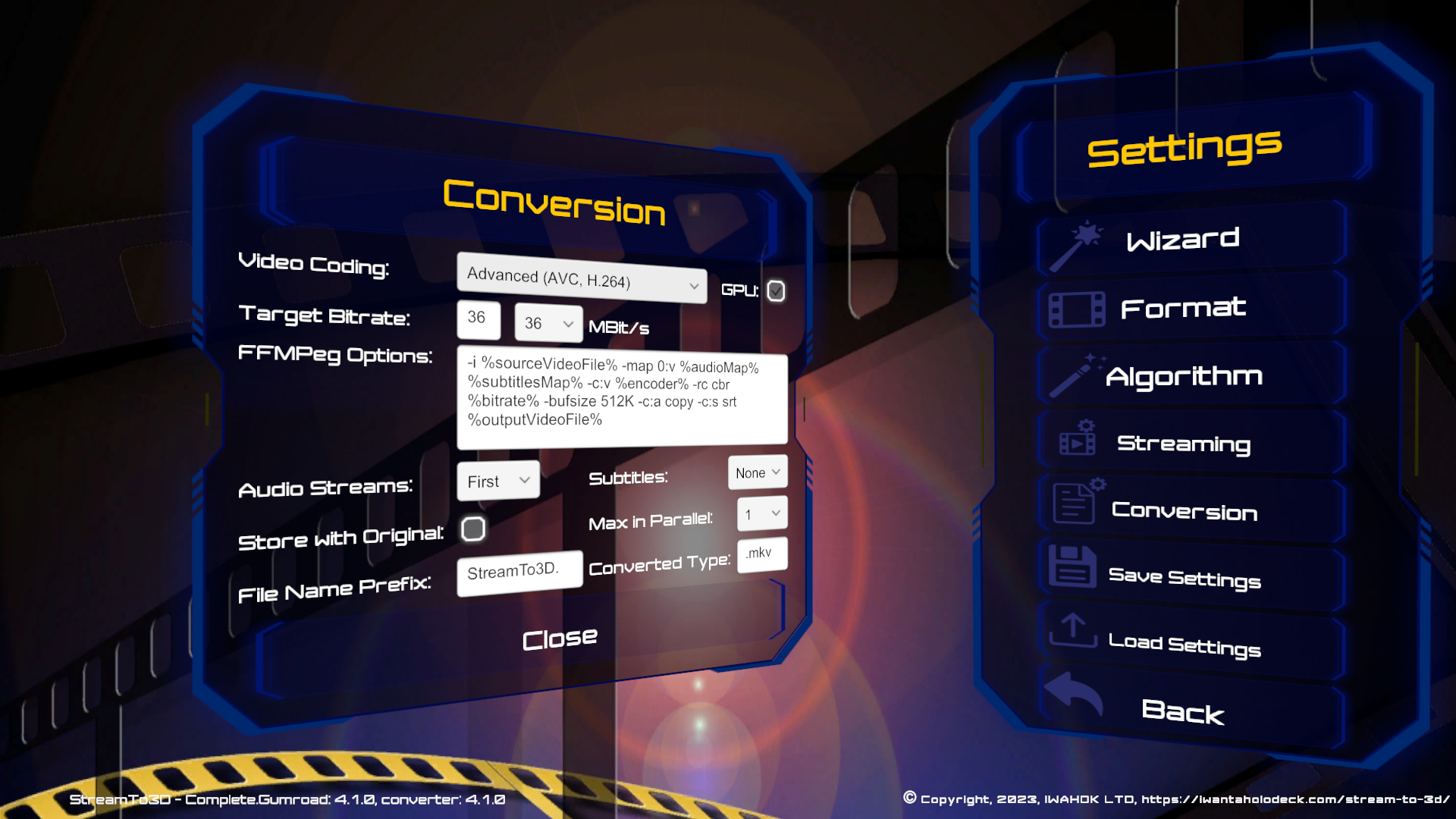
For detail on configuring the Video Coding, GPU Acceleration and FFMPeg options, see here.
From release 3.5, you can also specify how you would like audio and subtitle streams to be handled. By default, Stream to 3D will include only the first audio stream in the converted video and no subtitle streams. However, the conversion options allow optional inclusion of all audio streams and/or all subtitle streams. Just use the drop-down lists for "Audio Streams" and "Subtitles" to select the required behaviour.
To convert a 2D video to 3D, click "Convert" in the main menu and select the video file for conversion from the file selection dialogue box below. You can also, alternatively, select a ".txt" file containing a list of the path names to videos to convert, for batch mode processing:
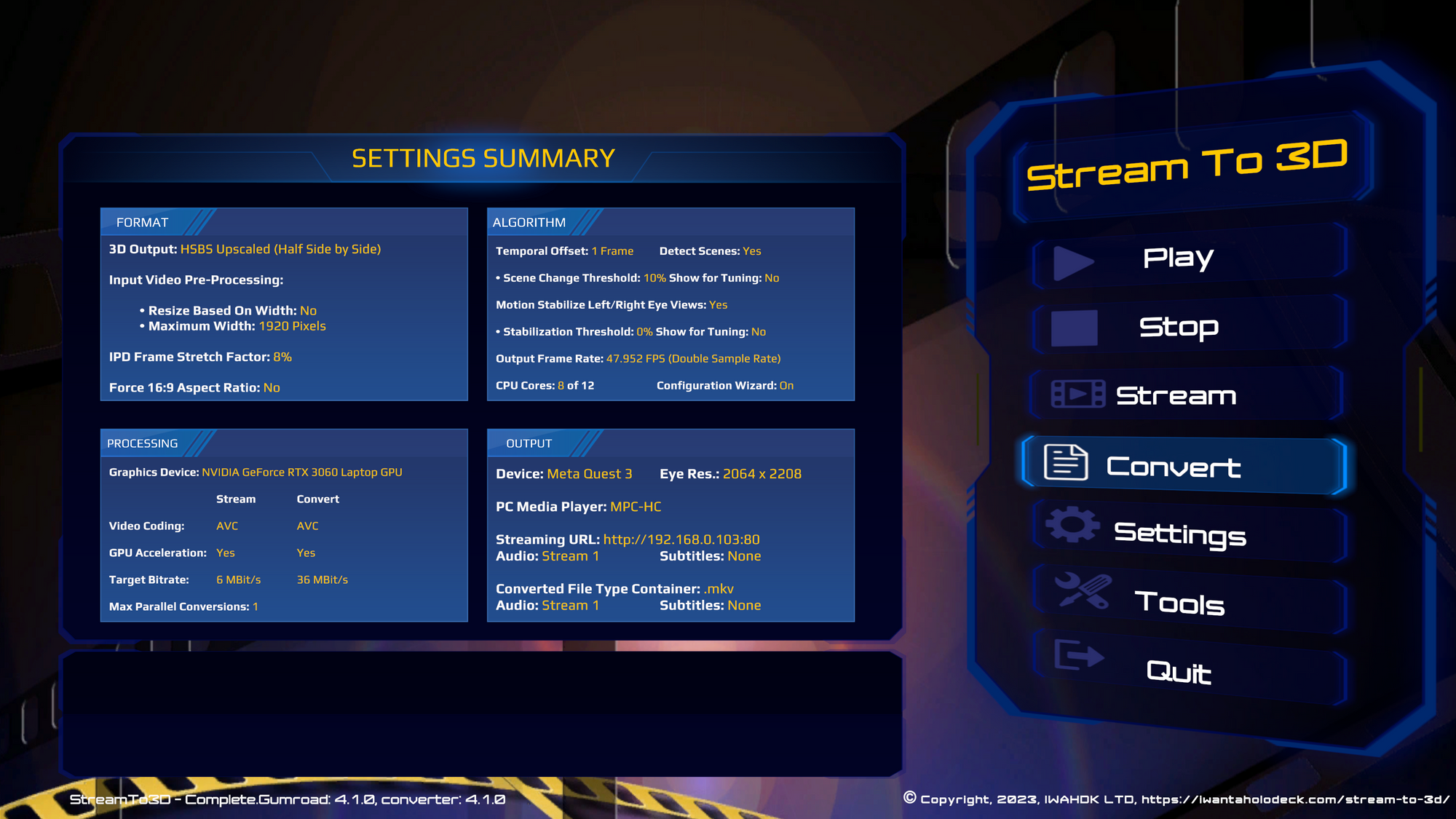
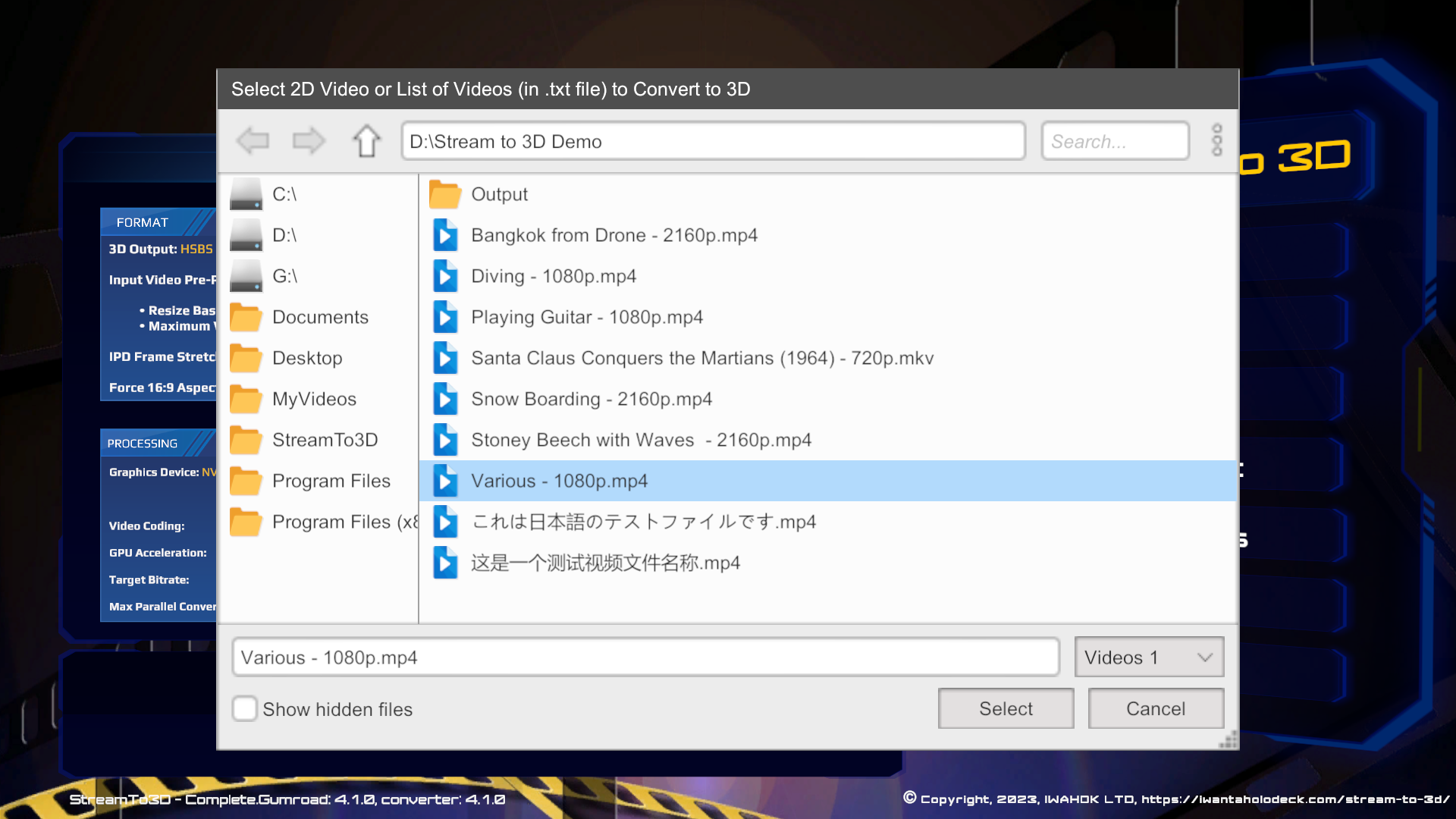
After selecting the source video file, you will be prompted for the destination video file name:
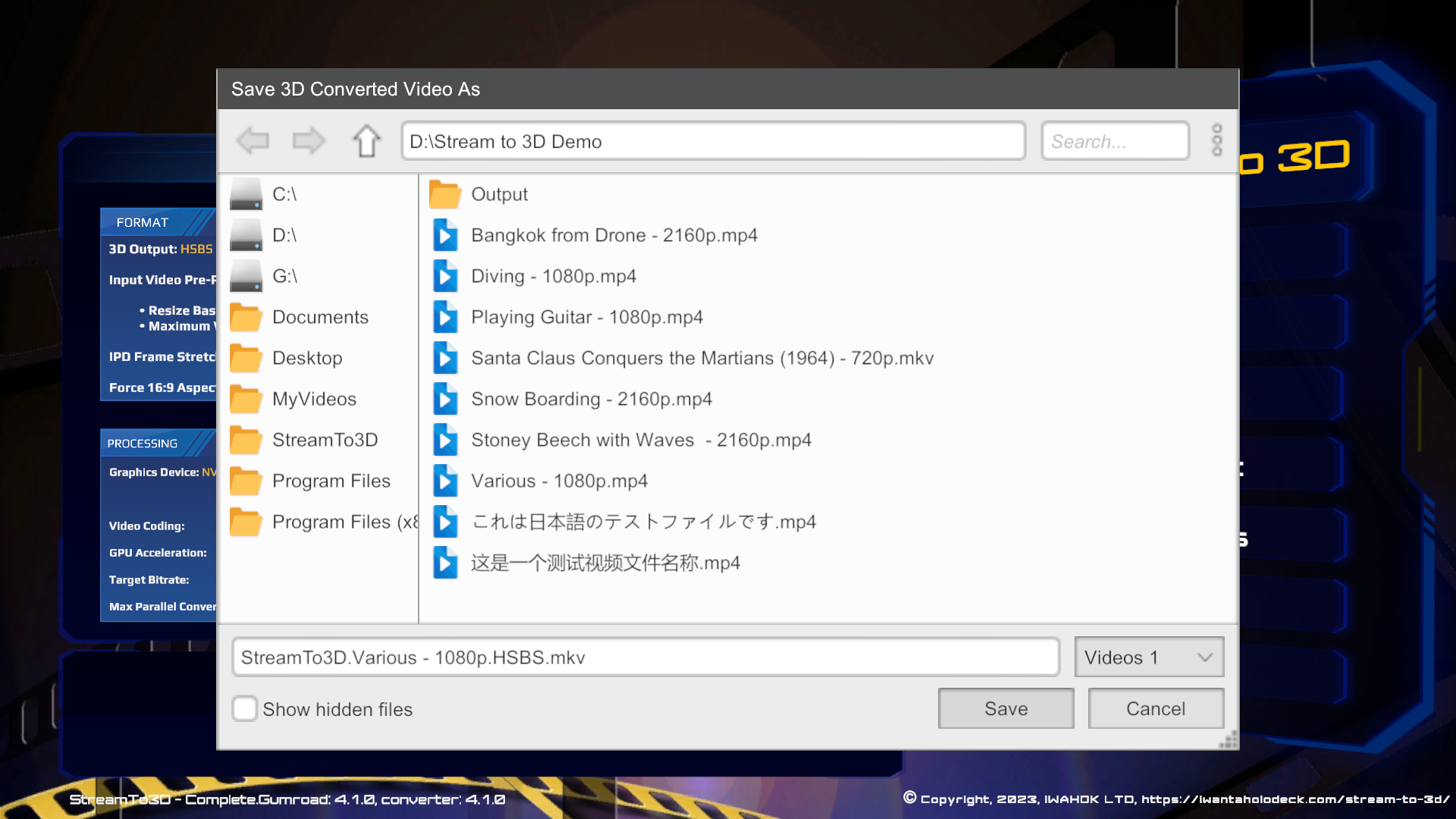
The default conversion output file format is ".mkv", this has changed from ".mp4" in earlier versions of Stream to 3D. It is easy to re-configure Stream to 3D to output ".mp4" files instead, by following the guidance here, you might need this for BigScreen as it does not support ".mkv" files.
The main reason for the move to ".mkv" is to recognise the benefit of this container format, in that the output video file can be read by a media player while the conversion process is still in progress. This means that you can begin to play the converted 3D output in your media player before conversion completes and indeed in real-time if the conversion process is running at a speed greater than the playback speed. The ".mkv" container format also supports a wider range of codecs, reducing the need for re-encoding which helps with both quality and speed of conversion.
Conversion of the video file will begin once you have selected the destination file name. You will be shown a progress bar detailing the time taken so far to convert the video, an estimate of the time remaining to complete, the percentage progress and the name of the file being converted. The Cancel button presented will allow you to cancel an in progress conversion.
Note that for high resolution, long duration videos or videos involving frame rate conversion, the process may take many hours. The time taken will also depend on the encoding scheme chosen, for example GPU accelerated encoding is much faster than software based, and the number of conversions being processed in parallel:
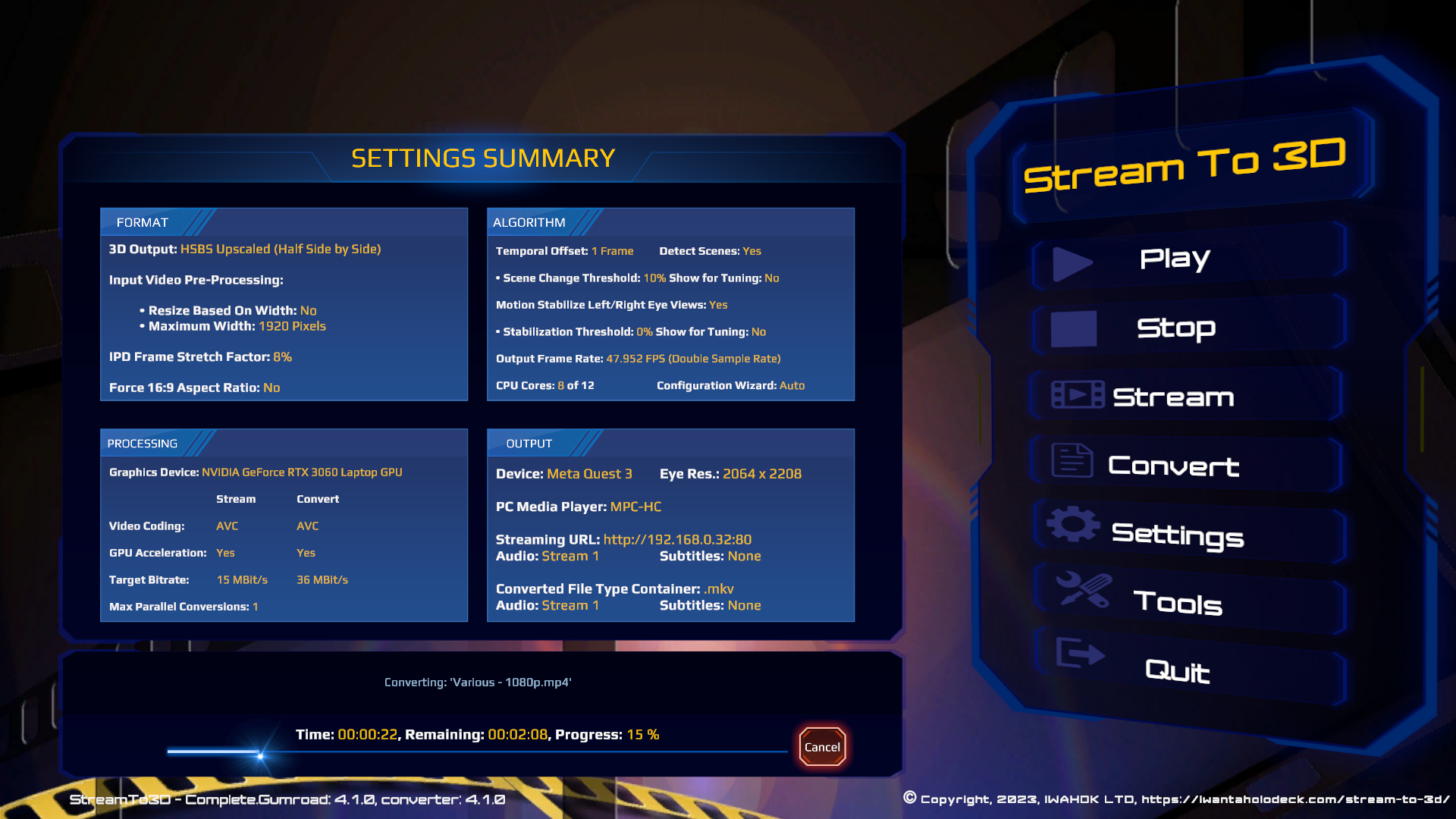
Once the video conversion process is complete, you will be offered the opportunity to play the converted version, via the green play button shown in the screen shot below:
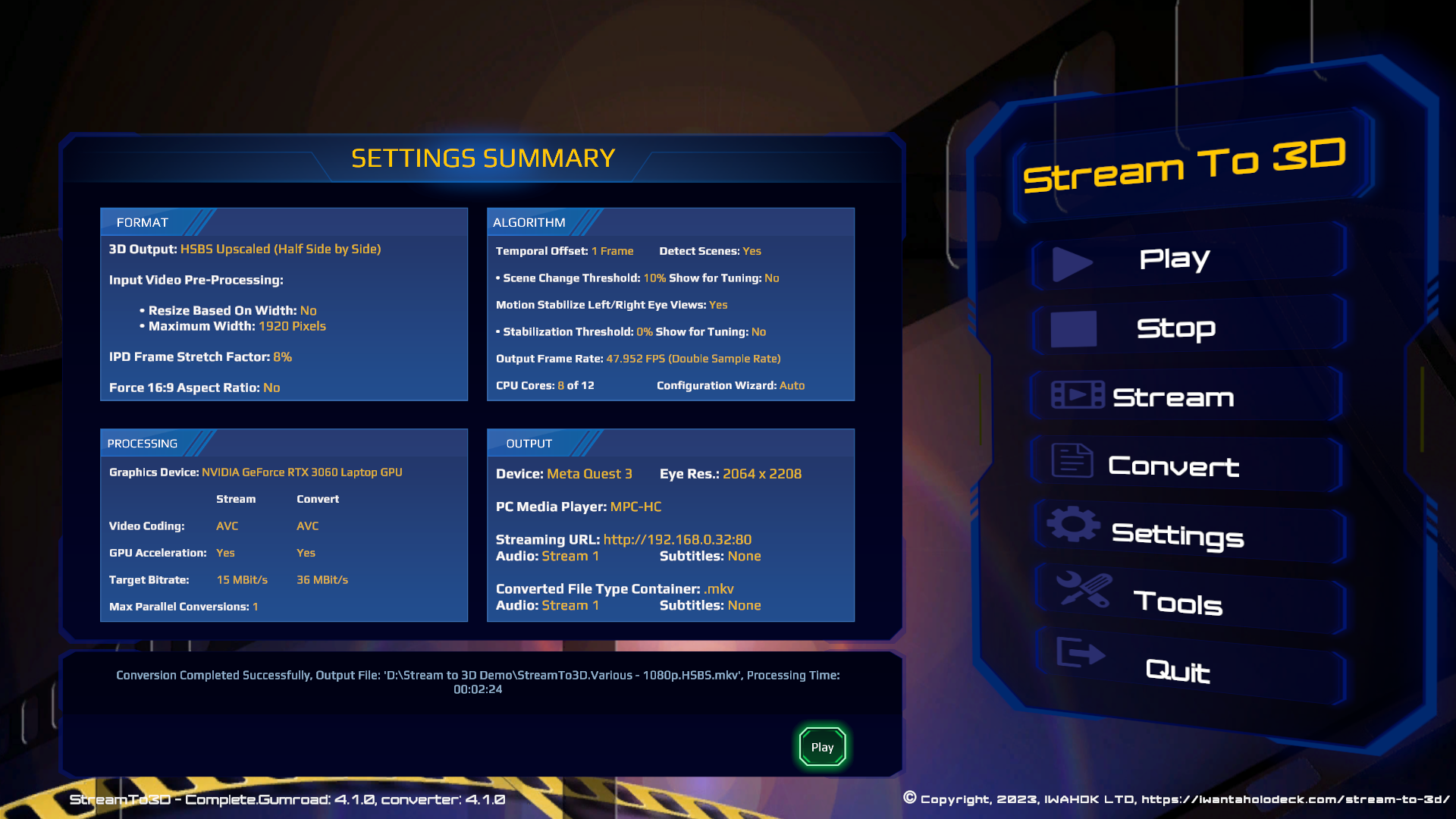
Batch Conversion of 2D Videos to 3D and Settings [NA for Real-Time Product]
To convert a set of videos, first create a text (".txt") with a list of the video files that you would like to convert, like a playlist (including their path names). An easy way to generate such a file from a directory structure containing candidate video files would be to open a CMD window (N.B. not a Terminal Window), change into the directory containing the video files, and enter a command similar to the one below:
dir * /s/b | findstr \.mkv > listOfFilesToConvertTo3D.txtThis will generate a text file called "listOfFilesToConvertTo3D.txt" containing a list of all of the ".mkv" video files in the current directory and its sub-directories. You can obviously change the file extension from ".mkv" in the command to match any other video formats that you need to process, e.g. ".mp4" in the example below:
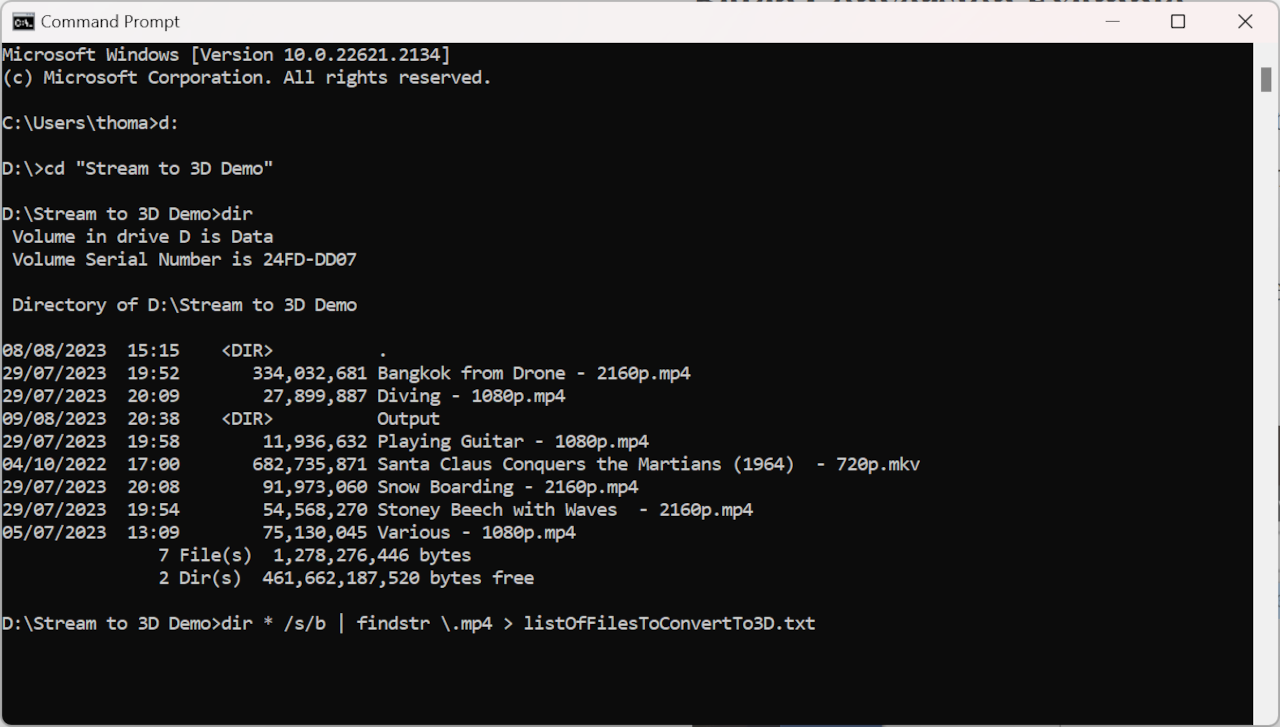
Once you have created this file, you can edit it to remove any files that you do not want converted. Note that the batch conversion process will try to ignore files that are already in 3D format. Stream to 3D uses file name pattern matching to distinguish 2D from 3D videos. By default, it will bypass the 2D to 3D conversion function for files that have "3D" in their names or contain ".SBS.", ".TB.", ".HSBS.", ".HTB." or ".3DA." (these being the 3D output formats that Stream to 3D can generate). You can modify this pattern as described here.
You can control several aspects of batch conversion in "Settings/Conversion":
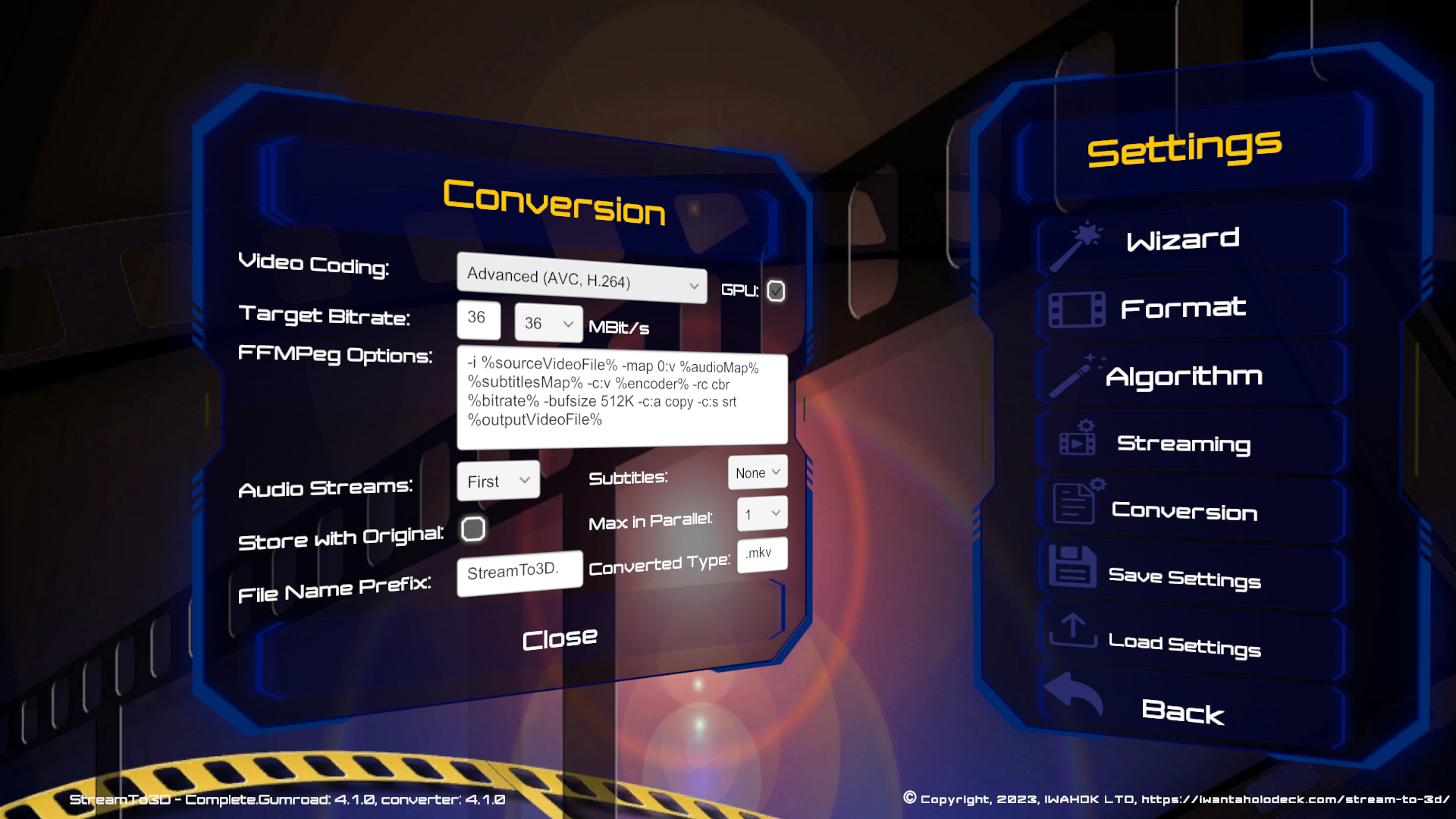
By default, when performing batch conversion, Stream to 3D will prompt for the destination folder in which to save converted videos. However, there is also the option to set Stream to 3D so that it stores converted videos in the same folders as the original videos. This is enabled by checking the "Store with Original" check box.
Stream to 3D can also be configured to support running multiple conversion processes in parallel. The "Max in Parallel" drop-down box will let you set the maximum allowed. Note: use this setting with caution as it can bring your machine to a stand still if you do not have enough processing capacity to run the maximum number or conversion processes specified.
The "File Name Prefix" item on this settings page allows you to specify a prefix file name for your converted videos. The default, as shown, is "StreamTo3D.", which can be edited and indeed left blank. A blank entry may be advisable to assist media players in looking up Meta data on your output video, based on the file name, which a file prefix can confuse.
The "Converted Type" item allows you to change the default type of converted videos to any format supported by FFMPeg (".mkv" is the default conversion type, as this container type allows the converted video to be read by media players, even as conversion progresses, thus supporting a wide range of media players for real-time conversion). Be careful in changing this type as other FFMPeg option items, e.g. codec options, may also need to change to be compatible with your chosen output type. As an example, you can re-configure Stream to 3D to output ".mp4" files by following the guidance here (you might need this for BigScreen as it does not support ".mkv" files).
Batch Conversion Example
Let's continue with a batch conversion example. Having created a text file listing the videos to convert to 3D, click "Convert" in the main menu. This will bring up the file selection dialogue below. You can use the filter drop-down to filter for text files. Navigate to your list file and select it:
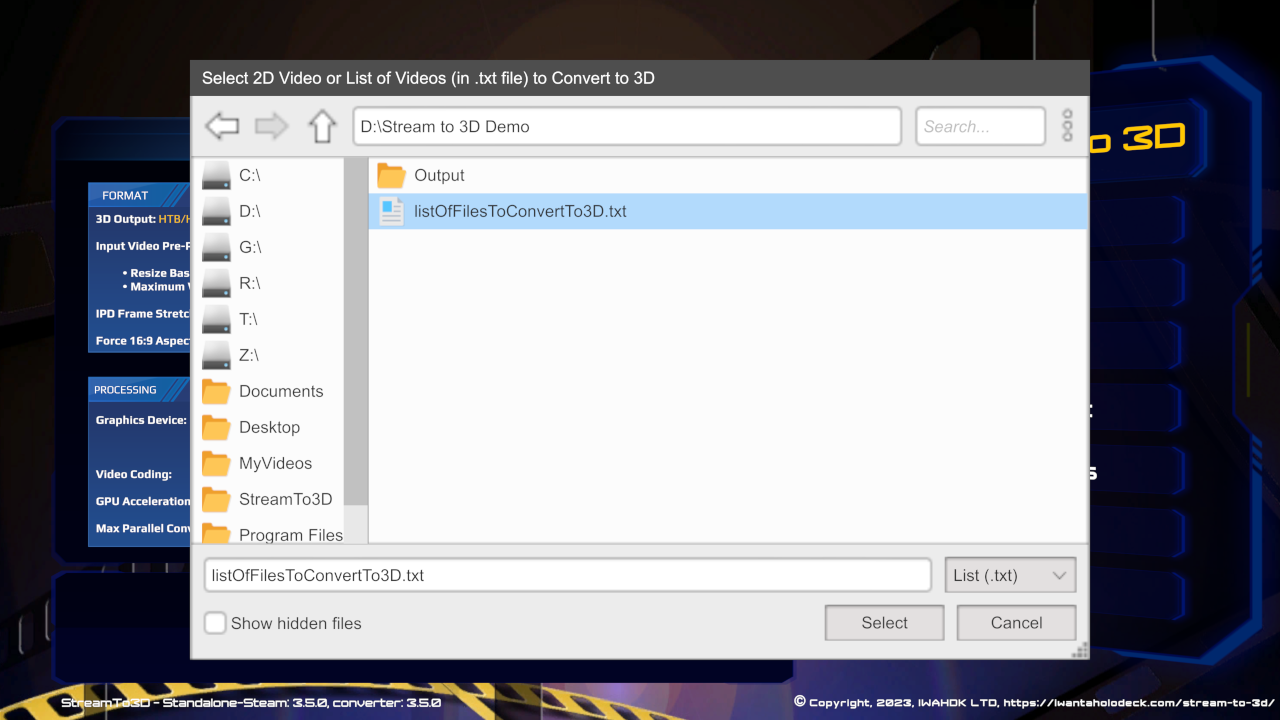
In this configuration, videos are set to be converted and saved in a single folder, so the next dialogue asks for the destination directory to be specified:
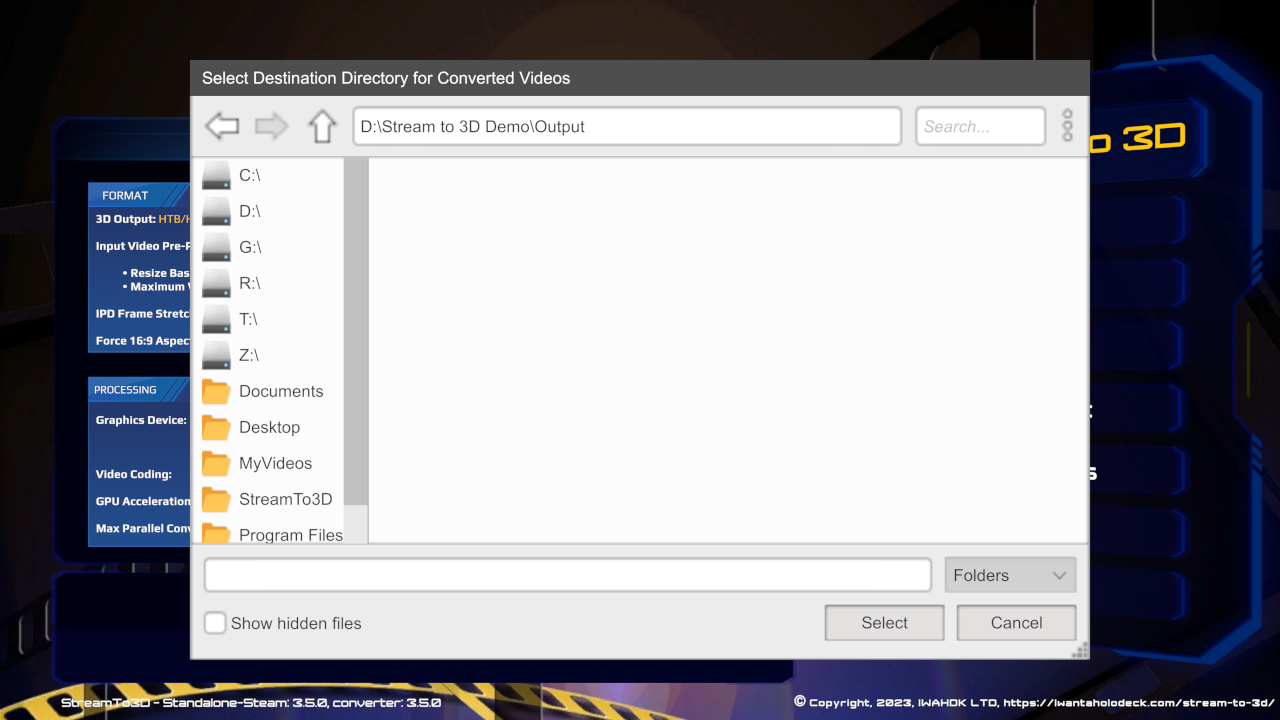
In the screen shot below, we can see the batch conversion in progress. There are two "Cancel" buttons.
The first "Cancel" button allows cancellation of conversion for the video whose progress bar is currently being displayed. The progress bar is displayed for 5 seconds at a time in a round-robin fashion for each video being converted. The number in the square brackets on the right gives a 5 second count down until when data for the next video in the list will be displayed. This gives time for you to review progress of each video and decide on whether you would like conversion to continue for that video, given the data on time remaining etc displayed in the progress bar. Note that the conversion process can take many hours for long videos.
The second "Cancel All" button will cancel conversion for all video conversions in progress.
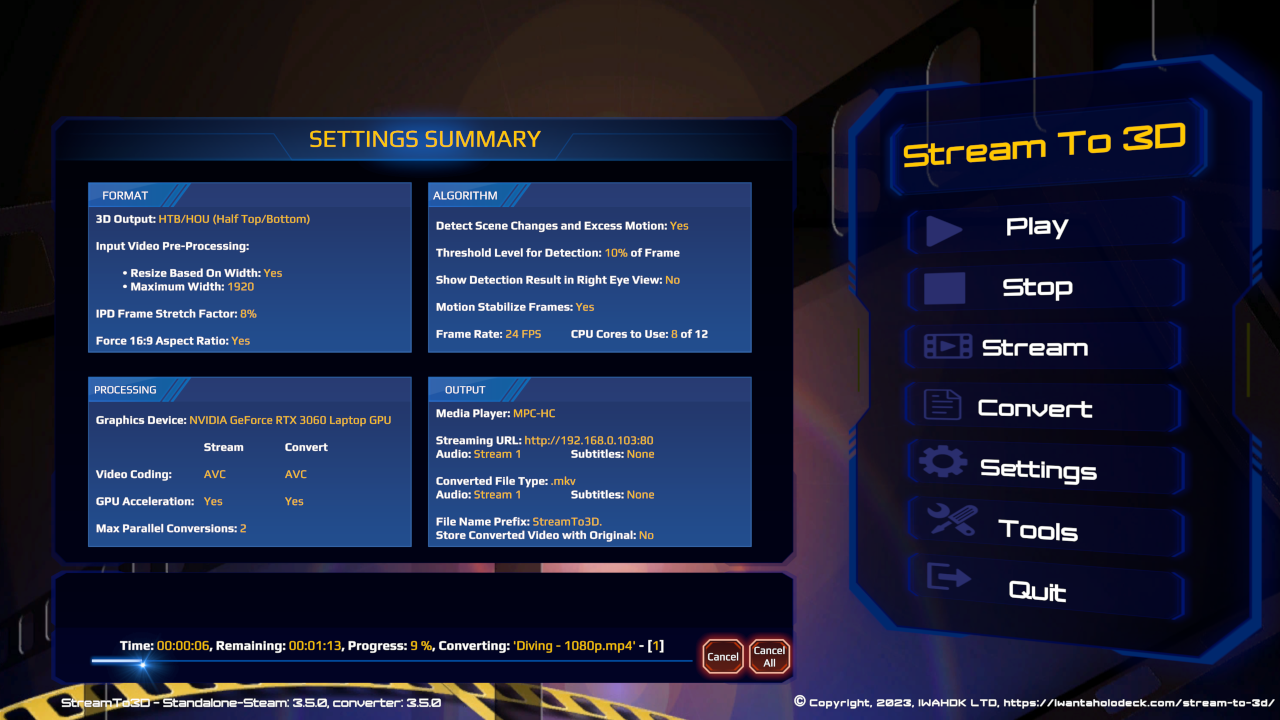
The screen shot below shows the display when batch conversion is complete. A summary showing a count of successful, failed and cancelled conversions is provided together with a button that allows review of the conversion summary log file:
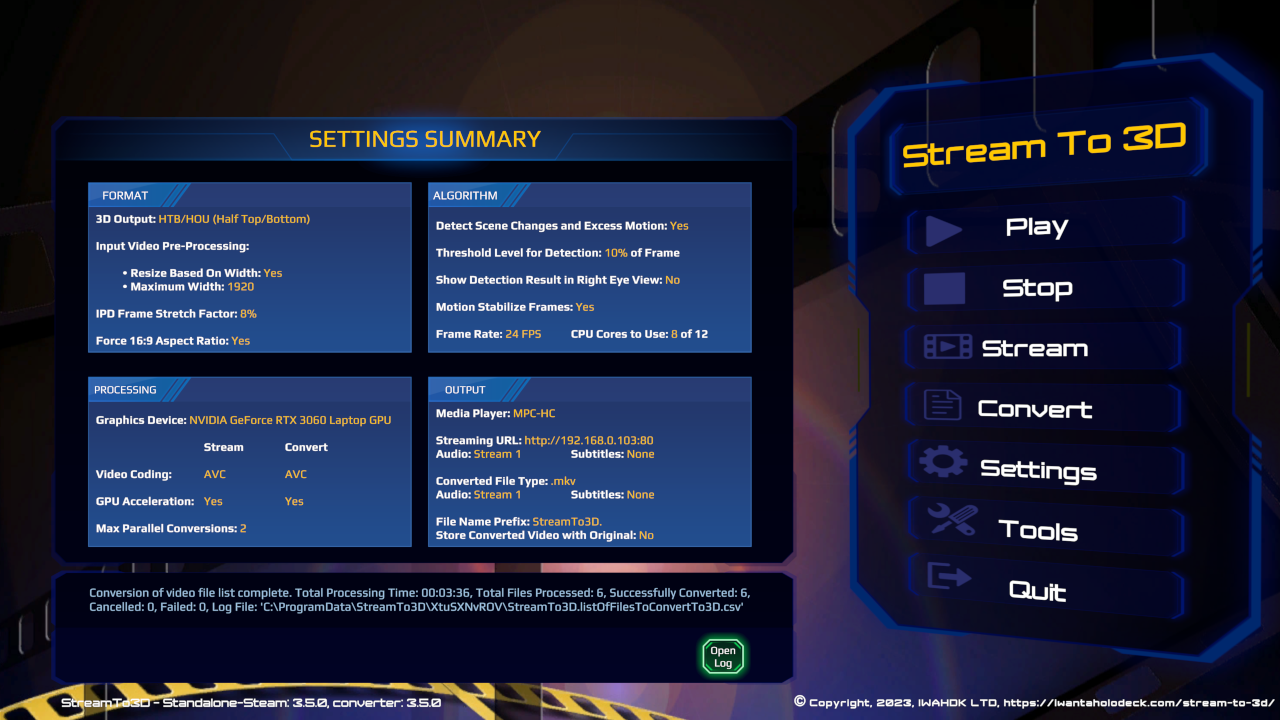
For detailed information on batch conversion status, Stream to 3D creates a ".csv" log file containing the batch conversion results, listing; the date and time of conversion completion for each file, the source video path, the converted video path, the processing time and (if applicable) the path to the log file for failed video conversions for diagnosis purposes. See example below:
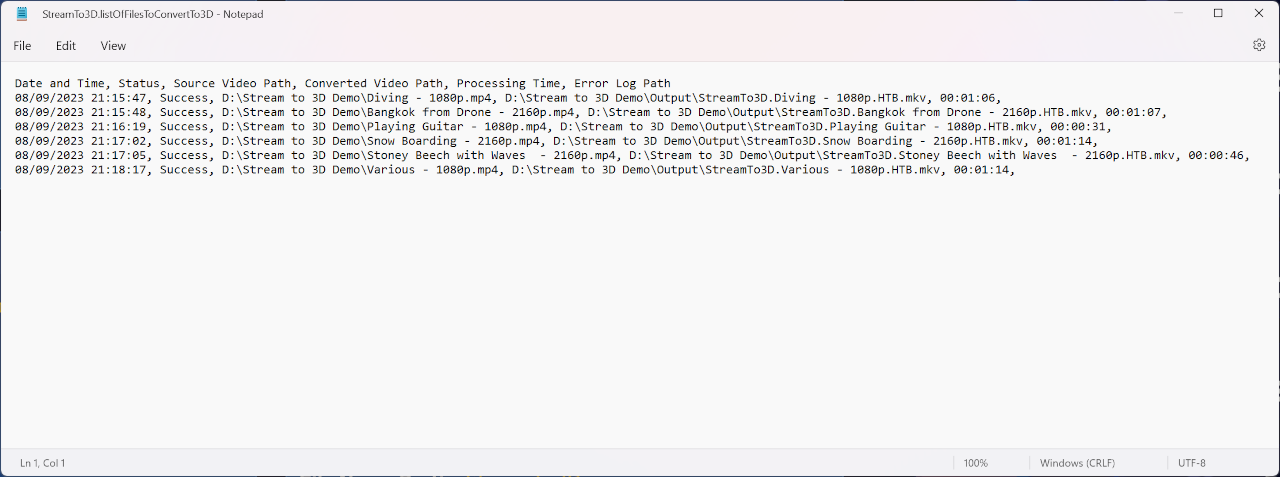
Click here to go to the Usage and Configuration home page.